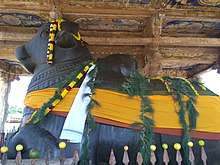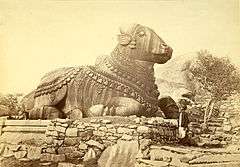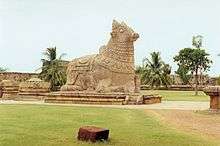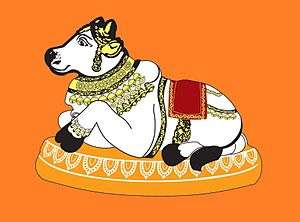Nandi (bull)
| Nandi | |
|---|---|
 Nandi in a zoo-anthropomorphic form | |
| Affiliation | Mount of Shiva |
| Abode | Kailasa |
| Consort | Suyasha[1] |
| Part of a series on |
| Shaivism |
|---|
 |
|
Deities |
|
Scriptures and texts |
|
Practices |
|
Schools
Saiddhantika Non - Saiddhantika
|
|
Related
|
Nandi (Sanskrit: नन्दि, Tamil: நந்தி, Kannada: ನಂದಿ, Telugu: న౦ది, Odia: ନନ୍ଦି) is the name of the gate- guardian deity of Kailasa, the abode of Lord Shiva. He is usually depicted as a bull which also serves as the mount to the god Shiva. According to Saivite siddhantic tradition, he is considered as the chief guru of eight disciples of Nandinatha Sampradaya - Sanaka, Sanatana, Sanandana, Sanatkumara, Tirumular, Vyagrapada, Patanjali and Sivayoga Muni who were send to eight directions to spread the wisdom of Shaivism.[2]

Etymology
The word nandi has come from Tamil root word Nandhu (Tamil: நந்து) means to grow, to flourish or to appear which was used to indicate growing fluorished white bulls as well as divine bull nandi.[3][4] The Sanskrit word nandi (Sanskrit: नन्दि) has the meaning of "happy", "joy" and "satisfaction"; also said as the properties of divine guardian of Lord Shiva - Nandi.[5] Almost all Shiva temples display stone images of a seated Nandi, generally facing the main shrine.
It is recently documented that the application of the name Nandi to the bull (Sanskrit: Vṛṣabha) is in fact a development of recent syncretism of different regional beliefs within Saivism.[6] The name Nandi was widely used instead for an anthropomorphic door-keepers of Kailasha rather than his mount in the oldest Saivite texts in Sanskrit, Tamil and other Indian languages. Siddhantic texts clearly distinct Nandi from Vṛṣabha. According to them, Devi, Chandesha, Mahakala, Vṛṣabha, Nandi, Ganesha, Bhringi and Murugan are eight Ganeshwaras (commanders) of Shiva.[7]
History and Legends
The worship of Shiva and Nandi can be traced to even Indus Valley Civilization time period. The famous 'Pasupati Seal' depicts a seated figure which is usually identified as Shiva and there were so many bull seals were found in Mohenjo daro and Harappa that led to conclude the researchers it might be the origin of Bull - cum - Nandi worship.[8]
Nandi is described as the son of the sage Shilada. Shilada underwent severe penance to have a boon — a child with immortality towards Lord Shiva and got Nandi as his son. It is said that Nandi was born from a Yajna performed by the Shilada and his body was clad in armour made out of diamonds when he was born.[9] Nandi grew as an ardent devotee of Lord Shiva and he did penance to become the gate-keeper of the Lord Shiva as well as his mount on the Banks of River Narmada near Tripur tirth Kshetra present day Nandikeshwar Temple, Bargi, Jabalpur in Madhya Pradesh

Nandi got the divine knowledge of Agamic and Tantric wisdom taught by Lord Shiva from goddess Parvati. He could teach that divine knowledge to his Eight disciples who are identified as the progenitors of Nandinatha Sampradaya - Sanaka, Sanatana, Sanandana, Sanatkumara, Tirumular, Vyagrapada, Patanjali and Sivayoga Muni. These eight disciples are directed to eight directions of the world by Nandinatha to spread the wisdom he taught them.[2]
Many other puranic tales are available about Nandi. One describes his conflict with Ravana, the anti-hero of Ramayana. Nandi cursed Ravana (the demon King of Lanka) that his kingdom would be burnt by a monkey (Vanara). Later Hanuman burnt Lanka when he went in search of Sita, who was kept prisoner by Ravana in Ashok Vatika.[10]
Tamil Thiruvilaiyadal Puranam mentions another story in which Nandi is incarnate as a whale.[11] It says that Parvati lost her concentration while Shiva was explaining the meaning of Vedas to her. Parvati then incarnated as a fisherwoman to atone. To unite his master and his beloved wife, Nandi takes the form of a whale and starts to trouble the people. Fisherwoman Parvati's father told that anyone who killed the whale would marry his daughter. Later Lord Shiva takes the form of a fisherman, kills the whale and gets Parvati in her previous form.
Iconography and symbolism

Agamas describe him in a zoo-anthropomorphic form with the head of bull and four hands with antelope, axe, mace and abhayamudra. In his mount form, nandi is depicted as a seated bull in all Shiva temples, all over the world. This nandi form has been found even in Southeast Asian countries including Cambodia.[12]
The white color of the bull symbolizes purity and justice.. Symbolically, the seated Nandi towards sanctum in Siva temples, represents an individual jiva (soul) and the message that the jiva should always be focused on the Parameshwara. From the yogic perspective, Nandi is the mind dedicated to Lord Siva, the Absolute. In other words, to understand and absorb Light, the 'experience and the wisdom' is Nandi which is the Guru within.[13]
Nandi Flag
Nandi Flag or Vrshabha Flag, a flag with the emblem of seated bull is recognized as the flag of Saivism, particularly among Tamil community all over the world. Nandi was the emblem of historical Tamil Shaivite monarches such as Pallava dynasty and Jaffna Kingdom.[16] Several campaigns to aware the Saivites about their Nandi flag is carried out continuously during the Shivaratri session particularly among Tamil community of Sri Lanka, Tamil Nadu and diaspora.[17]
The nandi flag used nowadays was designed by Mr.Ravindra Sastri of Madurai, Tamil Nadu according to the request and guidance of Mr.S.Danapala, a Sri Lankan Saivite personage in the 1990s. The first Nandi flag was hoisted in 1998 at Colombo Hindu College at Ratmalana, Sri Lanka.[18][19] Following years, It was declared as the official saivite flag in Fourth international Saiva Siddhanta Conference held at Zurich in 2008 [15] Nowadays Tamil Saivites, especially in Sri Lanka, Canada, Australia, UK, South Africa and Switzerland hoist Nandi Flag in their all religious and cultural festivals.[15][18][19] Nandi flag is declared as the official Hindu flag of Sri Lanka.[20][21]
See also
- Kamadhenu
- Cattle in religion
- Gavaevodata, the primordial cow in Zoroastrianism
References
- ↑ Gopinatha Rao, T. A. (1997). Elements of Hindu Iconography, Volume 2. Motilal Banarsidass Publishers. p. 213. ISBN 9788120808775.
- 1 2 Satguru Sivaya Subramuniyaswami (2003) "Dancing with Siva: Hinduism's Contemporary Catechism" Himalayan Academy Publications
ISBN 9780945497899. templatestyles stripmarker in
|title=at position 126 (help) - ↑ Tamil Etymological Dictionary Vol.5, Part I. Directorate of Tamil Etymological Dictionary, Government of Tamil Nadu, India. 2005. pp. 153–156.
- ↑ University of Kerala. Dept. of Linguistics (2007). "Nandi". International Journal of Dravidian Linguistics: IJDL. 36: 138.
- ↑ "Monier Williams' Sanskrit-English Dictionary". Retrieved 5 March 2017.
- ↑ Gouriswar Bhattacharya, (1977), "Nandin and Vṛṣabha", Zeitschrift der Deutschen Morgenländischen Gesellschaft, Supplement III,2, XIX. Deutscher Orientalistentag, pp. 1543-1567.
- ↑ Sabaratnam Sivacharyar, Dr.S.P. Shrimat Kamigagamah Purva Pada (Part One). USA: The Himalayan Academy, Kauai Adheenam. pp. 4:471-500.
- ↑ R. C. Dogra, Urmila Dogra (2004). Let's Know Hinduism: The Oldest Religion of Infinite Adaptability and Diversity. Star Publications. ISBN 9788176500562.
- ↑ Chidatman (Swami.) (2009). The sacred scriptures of India, Volume 6. Anmol Publications. p. 79. ISBN 9788126136308.
- ↑ Jayantika Kala. Epic Scenes in Indian Plastic Art. Abhinav Publications. p. 37. ISBN 9788170172284.
- ↑ Indian Association for English Studies. The Indian Journal of English Studies, Volume 34. Orient Longmans. p. 92.
- ↑ "Shiva and Uma on the Bull Nandi". The Walters Art Museum.
- ↑ Vanamali - (2013). Shiva: Stories and Teachings from the Shiva Mahapurana. ISBN 1620552493.
- ↑ DBS.Jeyaraj (2013). Reviving Practice of Hoisting ‘Nandi’ (Crouched Bull) Flag As Hindu Festivals and Functions,.
- 1 2 3 Kalabooshanam Chelvathamby Manickavasagar (2008). "Fourth International Saiva Siddhantha Conference and the Glory of Nanthy Flag". The Island. Retrieved 5 March 2017.
- ↑ Rasanayagam, Mudaliyar (1926). Ancient Jaffna, being a research into the History of Jaffna from very early times to the Portuguese Period. Everymans Publishers Ltd, Madras (Reprint by New Delhi, AES in 2003). பக். 390. ISBN 81-206-0210-2.
- ↑ "Hiduism Today, (2008),Hindu Campaigns for Restoration of Nandi Flag Tradition". Retrieved 5 March 2017.
- 1 2 Taṉapālā, kalāniti., Ciṉṉatturai., (2013), "Nantikkoṭi ēṟṟīr! Koṭikkavi pāṭīr!", Omlanka Publication.
- 1 2 Ciṉṉatturai taṉapālā, (2008), "nantikkoṭiyiṉ mukkiyattuvamum perumaikaḷum", Manimekalai Publication.
- ↑ "Nanthi Flag to Maithripala Sirisena". Retrieved 5 March 2017.
- ↑ "Minister Swaminathan urged to Provide Nanthi Flags to Temples, Societies". Retrieved 5 March 2017.
External links
- Dictionary of Hindu Lore and Legend 2004 ( ISBN 0-500-51088-1) by Anna Dallapiccola
| Wikimedia Commons has media related to Nandi. |

